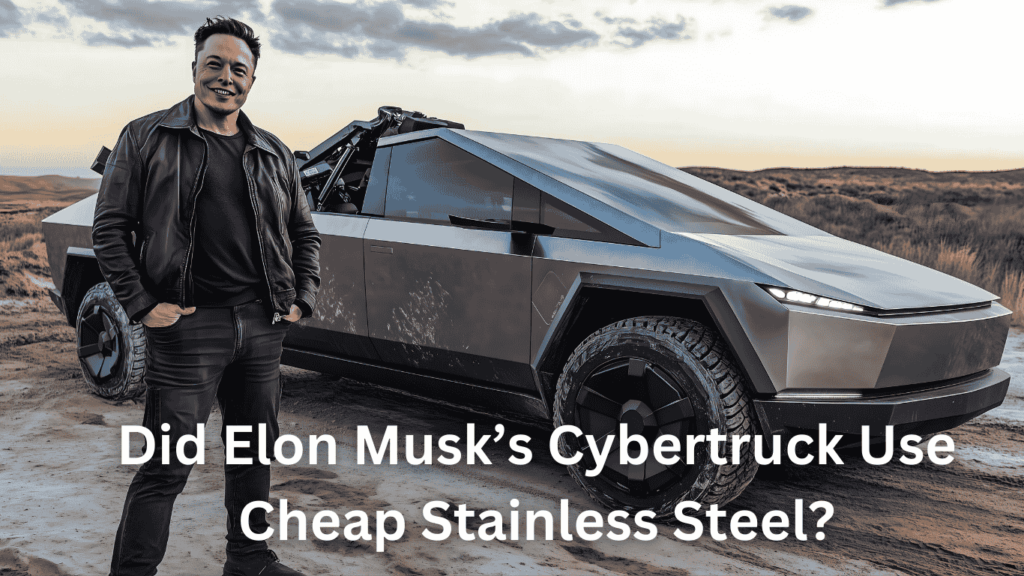When Elon Musk unveiled the Tesla Cybertruck in 2019, it sparked immediate conversation not just because of its futuristic design but also due to the material used in its construction—stainless steel. Tesla promoted the Cybertruck as a game-changer in the automotive industry, with an “exoskeleton” made from ultra-hard 30X cold-rolled stainless steel. However, questions began to surface. Did Elon Musk’s Cybertruck use cheap stainless steel? Is there more to the story than what initially appears?
Let’s break down the facts, the engineering choices, and whether or not Tesla compromised quality for cost.
The Stainless Steel Mystery: Is It Marketing Hype Or Material Innovation?
Tesla claimed the Cybertruck is built using the same stainless steel alloy as SpaceX’s Starship rocket—an ultra-durable, corrosion-resistant material. This alloy, believed to be 300-series stainless steel, is known for its strength and resistance to environmental damage.
But industry experts questioned the decision. Why was stainless steel chosen, given that it is notoriously hard to work with in automotive manufacturing? The answer lies somewhere between aesthetic innovation and strategic branding. Musk aimed to create something radically different. The Cybertruck’s use of stainless steel gave it a distinctive, raw metal look that exudes durability.
However, some critics argue that using stainless steel may not be as cost-effective or efficient as using traditional automotive materials like aluminum or high-strength steel. This raises the inevitable question: Was the stainless steel used truly high-grade or a lower-grade alternative?
What Type Of Stainless Steel Is Used In The Cybertruck?
Based on statements from Elon Musk and leaked specs, the Cybertruck’s body is made from 30X cold-rolled stainless steel, which Tesla claims to be custom-developed in collaboration with SpaceX. While exact details remain proprietary, it’s believed to be similar to SAE 304 or 301 stainless steel, offering a mix of formability, strength, and corrosion resistance.
These grades are not cheap, but they are not aerospace-grade either. Industries such as construction, kitchen appliances, and some automotive parts widely use them; they may not be cutting-edge, but they are certainly not substandard.
Thus, while it’s not “cheap” stainless steel by industrial standards, it’s also not as exotic or high-performance as titanium or carbon fiber. Tesla likely chose a middle ground—a material strong enough to meet Musk’s promises, but not so expensive that it would destroy profitability.
The Benefits Of Using Stainless Steel
There are a few reasons why stainless steel makes sense for Tesla, especially for the Cybertruck:
- Corrosion Resistance—Stainless steel doesn’t rust, which is critical for long-term vehicle durability.
- No Paint Needed—Its raw aesthetic means Tesla saves on paint costs and time.
- Extreme Strength—Ideal for a rugged vehicle marketed as “bulletproof.”
- Minimal Body Panels—The Cybertruck’s design uses fewer complex curves, making the difficult-to-mold stainless steel viable.
These benefits suggest that the choice of stainless steel wasn’t simply about cost-cutting but rather a deliberate material and design philosophy.
The Downsides: Weight, Manufacturing Challenges, And Repairs
Despite its strengths, stainless steel has drawbacks:
- Heavy Weight: Stainless steel is heavier than aluminum, potentially impacting range and efficiency.
- Manufacturing Difficulty: The material is tough to mold, stamp, or bend, leading to delays and unique production challenges.
- Repair Difficulty: Denting or damaging a stainless steel panel could require complete replacement, which may be more costly for consumers.
These disadvantages fuel the theory that Tesla may have opted for a less expensive or lower-grade version of stainless steel to make production more feasible.
Related :Elon Musk Stepping Down: What Does It Mean For Dogecoin And His Future Plans?
Comparing With Competitors
Contrary to most automakers, Tesla chose to use aluminum or specialized high-strength steel blends. For instance:
- Ford F-150 Lightning: Uses military-grade aluminum for weight savings and ease of manufacturing.
- Rivian R1T: Combines aluminum, high-strength steel, and composites for balance.
Tesla’s choice of stainless steel sets it apart but also adds complexity. It doesn’t necessarily mean they used cheap materials—just unconventional ones.
Public Perception: Is “Cheap” Just A Misconception?
Much of the conversation around “cheap stainless steel” stems from misunderstanding rather than facts. The term “cheap” often implies low quality. In Tesla’s case, the stainless steel used is likely cost-effective for Tesla’s unique needs, but not necessarily inferior. Tesla’s reputation—and Elon Musk’s branding style—often leads to hyperbole and skepticism. So, while the material may not be the most expensive stainless steel on Earth, calling it “cheap” doesn’t align with its actual properties or performance.
Conclusion: Cheap Or Clever Engineering?
So, did Elon Musk’s Cybertruck use cheap stainless steel? The answer is nuanced. Tesla chose a stainless steel variant that balances cost, strength, aesthetics, and manufacturability. It’s not the most advanced alloy, nor is it low-grade or budget-quality. In essence, the Cybertruck doesn’t use cheap stainless steel—it uses strategic stainless steel that fits its futuristic persona and marketing promise. Instead of taking shortcuts, the Cybertruck is redefining the potential of a truck by utilizing a material that is rarely utilized in the automotive industry.
FAQs
Q1. What Grade Of Stainless Steel Is Used In The Cybertruck?
A1. The Cybertruck uses 30X cold-rolled stainless steel, likely similar to 301 or 304-grade steel.
Q2. Is Stainless Steel Pricier Than Traditional Car Materials?
A2. Yes, it can be, especially in terms of manufacturing complexity, but Tesla offsets some of this cost with savings in painting and corrosion treatment.
Q3. Could You Explain Why Tesla Chose Not To Use Aluminum Like Other EV manufacturers?
A3. Elon Musk wanted a tougher, more durable material to reflect the rugged image of the Cybertruck, and stainless steel fits that narrative.
Q4. Can The Cybertruck Rust Or Corrode?
A4. Not easily—stainless steel is highly resistant to rust and corrosion.
Q5. Is The Cybertruck’s Steel Truly Bulletproof?
A5. Tesla has showcased it withstanding certain small arms fire, but this doesn’t make it impervious to all types of bullets or impacts.

